Explained: Joe Biden’s ban on Russian oil imports, and its impact on US, Europe and India
The US is the world’s largest producer and a net exporter of crude oil. In 2021, Russian crude oil accounted for about 10 per cent of US oil imports but about 30 per cent of the oil imports of Europe.

The United States on Tuesday banned all imports of Russian oil and gas and energy in an effort that US President Joe Biden said would hit “the main artery of Russia’s economy”. The UK has also announced plans to phase out imports of Russian crude oil by the end of 2022.
What does the ban entail?
monthly limit of free stories.
with an Express account.
The ban blocks any new purchases of Russian crude oil, certain petroleum products, liquefied natural gas, and coal, and winds down the deliveries of existing purchases that have already been contracted for according, to a senior official in the Biden administration.
🗞️ Subscribe Now: Get Express Premium to access the best Election reporting and analysis 🗞️
New investments from the US in Russia’s energy sector are also prohibited under the ban.
The ban does not, however, impact the ability of other countries to import Russian crude oil or natural gas. During his announcement of the import ban, US President Joe Biden clarified that while the import ban was decided in consultation with European allies, the US did not expect them or ask them to join in the import ban.
“The United States is able to take this step because of our strong domestic energy production and infrastructure. And we recognize that not all of our allies and partners are currently in a position to join us,” Biden said.
How dependent on Russian oil are the US and Europe?
The US is the world’s largest producer and a net exporter of crude oil. In 2021, Russian crude oil accounted for about 10 per cent of US oil imports but about 30 per cent of the oil imports of Europe.
European countries are particularly reliant on Russia for natural gas imports. In 2021, the European Union imported 155 billion cubic metres of natural gas from Russia, accounting for about 45% of EU gas imports and nearly 40% of the EU’s total gas consumption.
How will the ban affect crude oil prices?
Experts noted that as long as Russian crude oil supplies continue, there would not be a major impact on crude oil prices which are already near 14 year highs. Brent crude was trading at $130.8 per barrel on Wednesday (10.30 am IST), up 34 per cent since Putin announced military operations in Ukraine.
“Oil is a very sensitive and finely balanced global commodity. Any supply side disruption has a disproportionate impact on prices. As long as Russian crude supplies are continuing, this is more of a symbolic step coming from the US,” said Debasish Mishra, partner at Deloitte India.
Economic sanctions imposed by the US and Europe have already had some impact on exports of Russian crude oil. Analysts have noted that cargoes of Russian crude oil are struggling to find buyers with many concerned about the reputational damage from buying Russian crude which is now being offered at steep discounts due to sanctions.
How are rising crude oil prices going to affect Indian consumers?
The sharp uptick in crude oil prices comes as Indian consumers have been enjoying a four month reprieve from rising fuel prices with oil marketing companies (OMCs) having kept the price of petrol and diesel constant since early November.
With elections in Uttar Pradesh, Punjab, Uttarakhand, Manipur, and Goa having come to a close, consumers are expected to see a consistent increase in fuel prices starting this week as OMCs look to bring prices in line with international benchmarks and recoup losses.
The price of petrol and diesel have to be hiked by about 52 paise for every dollar increase in the price of crude oil for OMC marketing margins to remain constant. The price of crude oil has risen by about $50 per barrel since the price of petrol and diesel was last revised in November.
Petrol is currently retailing at Rs 95.41 per litre in the national capital while diesel is retailing at Rs 86.67 per litre.
Newsletter | Click to get the day’s best explainers in your inbox